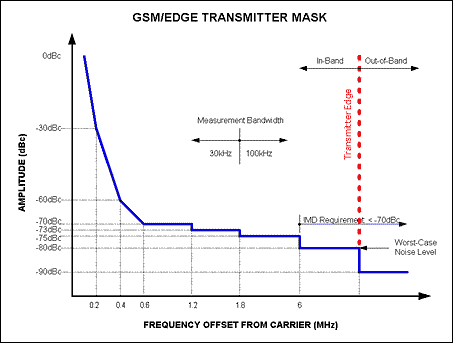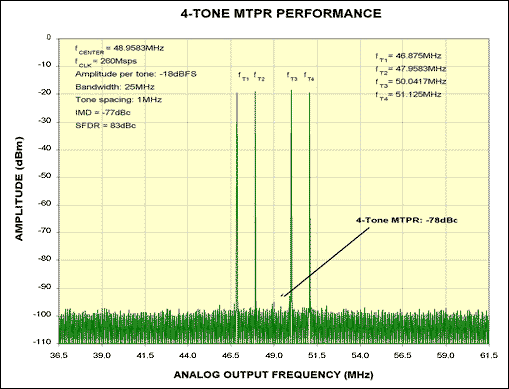
IntroductionEmerging wireless communications standards (wide-band, multi-carrier) demand increasingly lower distortion and noise specifications.The digital-to-analog converters (DACs) in the transmitter (Tx) circuits are the key components for analog signal generation. They can significantly influence the system's ultimate dynamic performance.
The transmitter sections of multi-carrier base station transceiver systems for GSM/EDGE present a chanllenge to communication DAC manufacturers. Manufacturers need to supply higher resolution and faster update rates, at higher output frequencies, all while reducing noise and spurious emissions over a wide bandwidth.
As a result of these requirements, GSM/EDGE system designers consider communications DACs attractive only if they can meet key specifications in four major noise and distortion categories. These are: Spurious-free Dynamic Range (SFDR), Signal-to-Noise Ratio (SNR), Intermodulation Distortion (IMD), and Multi-tone power ratio (MTPR). All four parameters are critical in ensuring that the Tx system meets required spurious and IMD targets. DAC Dynamic Performance Requirements for GSM/EDGETo specify noise and spurious emissions from base stations, a so-called GSM/EDGE Tx mask is used to identify the DAC requirements for these parameters. This mask shows that the allowable levels for noise and spurious emissions are dependent on the offset frequency from the transmitted carrier frequency. The GSM/EDGE mask and its specifications are based on a single active carrier with any other carriers in the transmitter being disabled. Specifications displayed in Figure 1 support per-carrier output power levels of 20W or greater. Lower output power levels will yield less stringent emission requirements.

Figure 1. The Tx mask helps to identify the noise and distortion limits for DACs, used in the transmission path of a GSM/EDGE-based Base Station Transceiver System.
Spurious-free Dynamic Range (SFDR) GSM/EDGE systems require the analog signal synthesis circuit block (the DAC) to have spurious emission levels of less than -80dBc for offset frequencies ≥ 6MHz. Spurious products from the DAC can combine with both random noise and spurious products from other circuit elements. The spurious products from the DAC should therefore be backed off a further 6dB (minimum) to allow for these other sources.
The number of carriers and their signal levels with respect to the full-scale of the DAC also play an important role. Unlike a full-scale sine wave, the inherent nature of a multi-tone signal, in which the spectral energy of the signal is spread over a defined bandwidth, contains higher peak-to-rms ratios, raising the prospect for potential clipping, if the signal level hasn't been backed off appropriately. If a transmitter operates with four in-band carriers, each individual carrier must be operated at >12dB below full-scale while eight carriers require an amplitude of >18dB below full-scale to preclude waveform clipping.
Example: An EDGE-based modulation has a peak-to-rms ratio of 4dB for the 8-PSK (Phase-Shift Keying) modulation employed. This requires the carrier amplitude to be backed-off by another 4dB. An additional margin of -6dB is used to compensate for other circuit elements. For systems with four/eight carriers per designated bandwidth, each individual carrier must satisfy an amplitude specification of -18dBFS/-24dBFS or less.
Signal-to-Noise Ratio (SNR) The SNR requirements for a GSM/EDGE-based system can again be derived from the GSM/EDGE Tx mask (Figure 1). With a worst-case noise level of -80dBc at frequency offsets of ≥ 6MHz and an assumed measurement bandwidth of 100kHz, the minimum noise density per Hertz is calculated as follows:
SNRMIN = -80dB - 10 × log10(100 × 10³Hz)Since random DAC noise will add to both the spurious tones and to random noise from other circuit elements, it is recommended to reduce the specification limits by about 10dB to allow for these additional noise contributions while maintaining compliance with the GSM/EDGE mask values.
SNRMIN = -130dB/Hz >
Intermodulation Distortion (IMD), and Multi-tone power ratio (MTPR)Other key factors in selecting a DAC for the Tx path of a multi-carrier GSM/EDGE system is the converter's ability to offer superior IMD and MTPR performance. Multiple carriers in a designated band will generate unwanted intermodulation distortion between the individual carrier frequencies. A multi-tone test vector usually consists of several equally spaced carriers, usually four, with identical amplitudes. Each of these carriers is representative of a channel within the defined bandwidth of interest. To verify MTPR, one or more tones are removed such that the intermodulation distortion performance of the DAC can be evaluated. Nonlinearities associated with the DAC will create spurious tones of which some may fall back into the area of the removed tone, limiting a channel's carrier-to-noise ratio. Other spurious components falling outside the band of interest also may be important, depending on the system's spectral mask and filtering requirements. Going back to the GSM/EDGE Tx mask, the IMD specification for adjacent carriers varies somewhat among the different GSM standards. For the PCS1800 and GSM850 standards, the DAC must meet an average IMD of -70dBc.
The following table summarizes the dynamic performance requirements for the entire Tx signal chain in a four-carrier GSM/EDGE-based system and compares the previously established converter requirements with a new generation high-dynamic performance DAC.
The 14-bit, 260Msps MAX5195 is the first DAC, which is fully compatible with 4-carrier GSM/EDGE signal generation. It provides excellent dynamic performance and meets all of the GSM/EDGE spectral mask requirements.
The four-tone MTPR plot (Figure 2) demonstrates the DACs superior dynamic performance. The center frequency (fCENTER = 48.9583MHz) has been removed to allow detection and analysis of intermodulation or spurious components falling back into this empty spot from adjacent channels. The four carriers are observed over a 25MHz bandwidth and are equally spaced at 1MHz. The output amplitude has been backed-off by -18dBFS according to the GSM/EDGE spectral mask. Under these conditions, the DAC yields an IMD of -77dBc and an MTPR of -78dBc.

Figure 2. This spectrum plot depicts the four-tone MTPR performance at fCENTER = 48.9583MHz and fCLK = 260MHz of the MAX5195, which meets the most critical GSM/EDGE specifications. ConclusionFrom a system point of view, the ability of the DAC to keep high degrees of dynamic performance under multi-tone conditions, eases the transmitter path design. Traditionally, BTS systems would employ one converter per transmit channel. Now however a DAC with sufficiently high multi-tone performance, will help to simplify the transmitter architecture and reduces board space and cost by cutting down on the number of DACs required in such a system.
Notes1 Single-carrier SFDR observed within a 25MHz window. Although the DAC doesn't meet the SFDR specification completely, a lower single-tone SFDR can be accommodated and compensated for by frequency planning.
A similar version of this article appeared in the October 2002 issue of Electronic Products magazine.
欢迎分享,转载请注明来源:内存溢出

 微信扫一扫
微信扫一扫
 支付宝扫一扫
支付宝扫一扫
评论列表(0条)